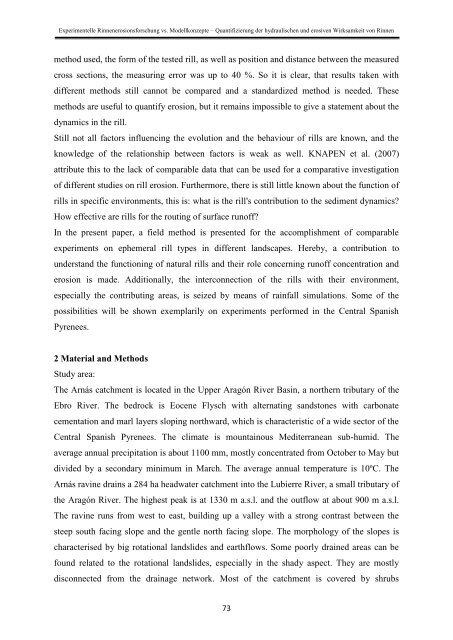Stefan Wirtz Vom Fachbereich VI (Geographie/Geowissenschaften ...
Stefan Wirtz Vom Fachbereich VI (Geographie/Geowissenschaften ...
Stefan Wirtz Vom Fachbereich VI (Geographie/Geowissenschaften ...
You also want an ePaper? Increase the reach of your titles
YUMPU automatically turns print PDFs into web optimized ePapers that Google loves.
Experimentelle Rinnenerosionsforschung vs. Modellkonzepte – Quantifizierung der hydraulischen und erosiven Wirksamkeit von Rinnen<br />
method used, the form of the tested rill, as well as position and distance between the measured<br />
cross sections, the measuring error was up to 40 %. So it is clear, that results taken with<br />
different methods still cannot be compared and a standardized method is needed. These<br />
methods are useful to quantify erosion, but it remains impossible to give a statement about the<br />
dynamics in the rill.<br />
Still not all factors influencing the evolution and the behaviour of rills are known, and the<br />
knowledge of the relationship between factors is weak as well. KNAPEN et al. (2007)<br />
attribute this to the lack of comparable data that can be used for a comparative investigation<br />
of different studies on rill erosion. Furthermore, there is still little known about the function of<br />
rills in specific environments, this is: what is the rill's contribution to the sediment dynamics?<br />
How effective are rills for the routing of surface runoff?<br />
In the present paper, a field method is presented for the accomplishment of comparable<br />
experiments on ephemeral rill types in different landscapes. Hereby, a contribution to<br />
understand the functioning of natural rills and their role concerning runoff concentration and<br />
erosion is made. Additionally, the interconnection of the rills with their environment,<br />
especially the contributing areas, is seized by means of rainfall simulations. Some of the<br />
possibilities will be shown exemplarily on experiments performed in the Central Spanish<br />
Pyrenees.<br />
2 Material and Methods<br />
Study area:<br />
The Arnás catchment is located in the Upper Aragón River Basin, a northern tributary of the<br />
Ebro River. The bedrock is Eocene Flysch with alternating sandstones with carbonate<br />
cementation and marl layers sloping northward, which is characteristic of a wide sector of the<br />
Central Spanish Pyrenees. The climate is mountainous Mediterranean sub-humid. The<br />
average annual precipitation is about 1100 mm, mostly concentrated from October to May but<br />
divided by a secondary minimum in March. The average annual temperature is 10ºC. The<br />
Arnás ravine drains a 284 ha headwater catchment into the Lubierre River, a small tributary of<br />
the Aragón River. The highest peak is at 1330 m a.s.l. and the outflow at about 900 m a.s.l.<br />
The ravine runs from west to east, building up a valley with a strong contrast between the<br />
steep south facing slope and the gentle north facing slope. The morphology of the slopes is<br />
characterised by big rotational landslides and earthflows. Some poorly drained areas can be<br />
found related to the rotational landslides, especially in the shady aspect. They are mostly<br />
disconnected from the drainage network. Most of the catchment is covered by shrubs<br />
73
















